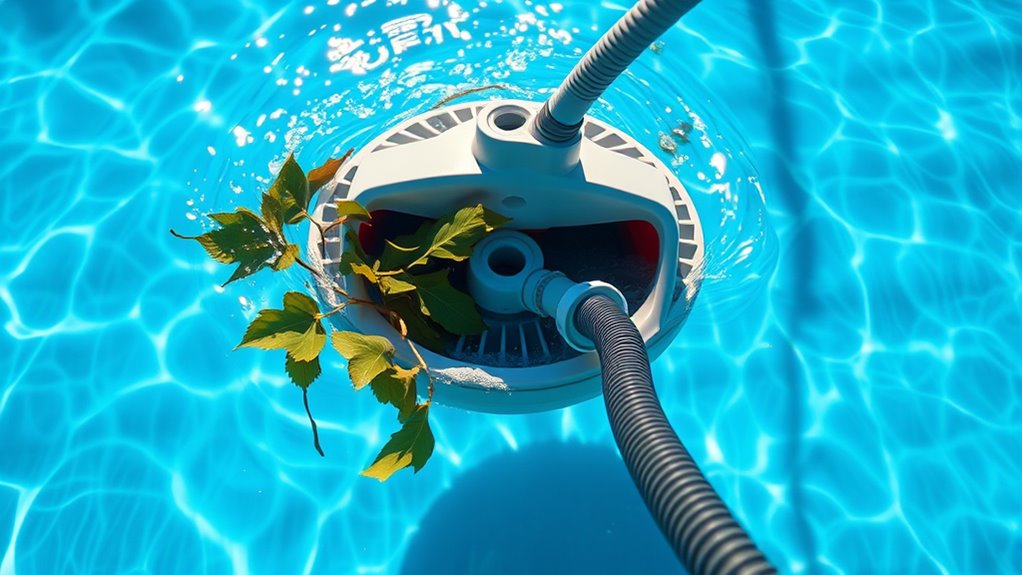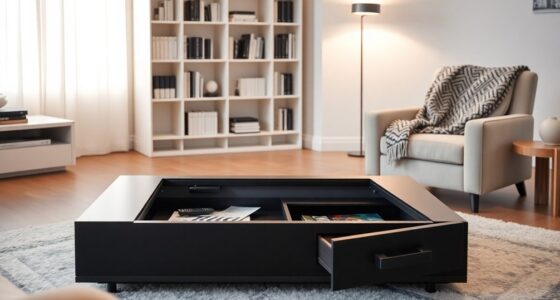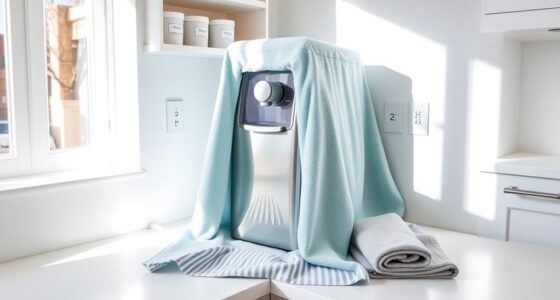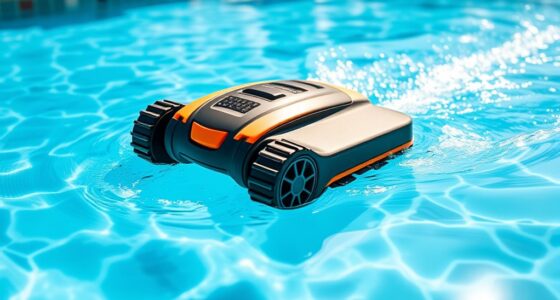To avoid common mistakes with your suction pool cleaner, make certain you attach it properly and keep hoses clear of kinks and blockages. Always turn off the pump before installing or removing the cleaner and follow manufacturer’s recommended settings. Regularly maintain filters, brushes, and hoses to prevent wear and buildup. Also, don’t rely solely on the cleaner—you should perform routine pool maintenance. Keep these tips in mind, and you’ll ensure your cleaner works efficiently and lasts longer.
Key Takeaways
- Ensure the cleaner is properly attached to avoid loss of suction and ineffective cleaning.
- Regularly inspect and clear hoses of kinks or blockages to maintain optimal water flow.
- Turn off the pump and power before installing or removing the cleaner to ensure safety.
- Do not run the cleaner continuously without supervision to prevent strain on equipment and energy waste.
- Perform routine maintenance, including cleaning filters and inspecting brushes, to prolong cleaner lifespan and efficiency.

Using a suction pool cleaner can make pool maintenance easier, but many users make simple mistakes that reduce its effectiveness. One common error is neglecting to follow proper pool maintenance tips, which can lead to inefficient cleaning and even damage to your equipment. Before you start, ensure the cleaner is correctly attached to your skimmer or dedicated suction line. Failing to secure it properly can cause the cleaner to lose suction, leaving debris behind. Regularly inspect the hoses for kinks or blockages, which can restrict water flow and diminish cleaning performance. Keeping hoses clear and in good condition is essential for maximum operation. Proper installation techniques are crucial to ensure the cleaner functions efficiently from the outset.
Another critical mistake is not paying attention to safety precautions. Always turn off the pump and power supply before installing or removing the cleaner. This prevents accidental injuries or damage to the device. If your pool has a variable-speed pump, set it to the appropriate speed recommended by the manufacturer. Running the cleaner at too high a speed can cause unnecessary strain on the equipment and increase energy costs. Additionally, never leave the cleaner unattended while the pump is running, especially if children or pets are nearby, to avoid accidental entanglements or mishaps.
Many users also overlook the importance of regular maintenance and cleaning of the suction cleaner itself. Accumulated debris or tangled brushes can considerably reduce its effectiveness. Check and clean the filter or bag frequently, especially after heavy use or storms. This prevents clogs and ensures continuous suction power. It’s also wise to check the wheels and brushes periodically for wear and tear, replacing them as needed to maintain proper movement and cleaning coverage. Ensuring proper equipment upkeep can significantly improve cleaning efficiency. Additionally, maintaining optimal hose conditions prevents leaks and loss of suction, which is vital for consistent operation. Regular maintenance also extends the lifespan of your equipment, saving money in the long run.
Another mistake is relying solely on the suction cleaner to keep your pool clean. While it’s effective for surface debris and some dirt, it doesn’t replace regular skimming, brushing, and chemical balancing. These additional pool maintenance tips are necessary for overall water quality and clarity. Using the cleaner as part of a thorough maintenance routine will extend its lifespan and improve your pool’s appearance. Additionally, understanding the importance of expert voice actors can help in choosing high-quality ads if you promote pool-related products or services.
Finally, avoid running the suction pool cleaner for extended periods without monitoring. Overuse can strain the pump and reduce its lifespan. Follow the manufacturer’s recommended cleaning cycles, usually a few hours per session, and check the system regularly for issues. By paying attention to these simple yet vital details, you’ll maximize your cleaner’s efficiency, ensure safety, and keep your pool sparkling clean and inviting.
Frequently Asked Questions
How Often Should I Replace My Suction Pool Cleaner Parts?
You should replace your suction pool cleaner parts based on wear and tear, typically every 1 to 3 years. Regular pool maintenance helps extend the equipment lifespan, but check hoses, brushes, and diaphragms regularly for damage or deterioration. Replacing worn parts ensures your cleaner operates efficiently, preventing costly repairs and keeping your pool clean. Staying proactive with maintenance will maximize your equipment’s longevity and keep your pool in top condition.
Can I Use a Suction Pool Cleaner on a Saltwater Pool?
Imagine your pool sparkling under the sun, inviting you for a dip. Yes, you can use a suction pool cleaner on a saltwater pool. Just follow some simple pool cleaning tips, and verify your cleaner is saltwater compatible. Check the manufacturer’s guidelines first. With proper care, your cleaner will work efficiently, helping you maintain crystal-clear water while prolonging its lifespan in the salty environment.
What Is the Ideal Pool Size for a Suction Cleaner?
The ideal pool size for a suction cleaner depends on your pool’s dimensions and the suction power of your cleaner. Generally, smaller pools, up to 20 feet in diameter, work well because they’re easier to clean efficiently. Larger pools may require a more powerful suction or a robotic cleaner. Make certain your suction power matches your pool size to guarantee thorough cleaning without overworking your equipment.
How Do I Troubleshoot When My Suction Cleaner Loses Suction?
Losing suction feels like your pool cleaner is throwing a tantrum. To troubleshoot, first check for clogs in the hose or skimmer basket, as these block the flow. Make certain the vacuum head and hose are properly connected and not damaged. Inspect the pump basket and filter for debris, and verify the water level is high enough. These troubleshooting tips help restore your cleaner’s suction and keep your pool sparkling.
Are There Safety Precautions for Handling the Cleaner’S Debris Bag?
When handling your suction pool cleaner’s debris bag, always prioritize safety handling and proper debris bag disposal. Wear gloves to avoid contact with dirt or potential bacteria, and carefully remove the bag to prevent spills. Dispose of the debris in accordance with local regulations, and wash your hands afterward. Regularly check and clean the bag to maintain ideal suction and guarantee safe, effective pool cleaning.
Conclusion
To keep your pool spotless, avoid these common suction cleaner mistakes. Regularly check and maintain your equipment, and don’t forget to clear the filter often. Did you know that about 60% of pool owners experience issues caused by improper cleaner use? Staying informed and attentive can save you time and money, ensuring your pool stays inviting and clean all season long. Keep these tips in mind, and you’ll enjoy a hassle-free swimming experience.










